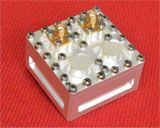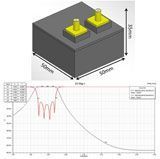
-
StatusCompleted
-
Status date2013-04-30
-
Activity Code5C.102
Coaxial filters are currently standard technologies for L-, S-band input filters. This technology has found wide application in mobile missions with multi-beam payloads, but also for TT&C and as IF filters, however, in L- and S-band this technology is inherently large and bulky since it is based on TEM air resonators.
The objective of the project is the assessment of new filter design concepts based on dielectric technology for L- and S-band applications to improve performances mainly in terms of mass and volume. Two Filter BBs and two Filter EMs have been manufactured and tested to fully evaluate the developed technology.
In the realization of L- and S-band input filters coaxial filters are currently used as a standard technology. Their employment allows for a wide range of flexibility as well as a low IL with excellent performances in terms of spurious free ranges. Despite its advantages, this technology in too large and bulky because TEM air resonators are employed. In last decades it has been proved that dielectric resonators can be employed instead of coaxial resonators in such a kind of filters with a footprint reduction up to 50% and maintaining the same in-band RF performances. Of course a good trade-off in terms of spurious performance, temperature stability, unloaded Q-factor and assembly issues must be found.
Potential advantages and disadvantages using dielectric resonators instead of empty metallic cavities have been reported together with a brief history of their employment and evolution in last decades. The main electromagnetic modes of dielectric resonators and their behaviours were analyzed and described in full-wave simulations as well as their use in possible filtering structures. TM010 mode dielectric resonators with high dielectric permittivity (>40) have been employed, they are the best solution for a good trade-off in terms of volume, spurious free range and Q-factor.
The main issues of the project are: to find a good tread-off in terms of unloaded Q-factor, spurious free range, compactness, thermal stability; to manage the mismatch of thermal expansion coefficients between dielectric and metal, thus to avoid the presence of an undesired air-gap between the dielectric rod upper and lower surfaces and the metal enclosure in the TM010 mode dielectric resonator; to make a robust RF filter due to its critical sensitivity to dielectric characteristics and to manufacturing and assembly process, thus to be able to compensate for the undesired tolerances of the process.
Coaxial filters are currently used as a standard technology in the realization of L- and S-band input filters. Their use allows for a wide range of flexibility i.e. for narrow bandwidth and for bandwidth up to one octave with excellent performances in terms of spurious free ranges. Despite its advantages, this technology is too large and bulky because TEM air resonators are employed. In the last decades it has been proved that dielectric resonators with high dielectric permittivity (>30) and low tanδ (<10-4) can be employed instead of coaxial resonators in such filters with a footprint reduction up to 50% while maintaining the same in-band RF performances. Obviously, a good trade-off in terms of spurious performance, temperature stability, Q-factor and assembly issues must be found. TM010 mode dielectric resonators at 2GHz allow for Q-factor above 4000 (that fulfils the project requirements) and filter footprint reduction of 50% with respect to conventional TEM mode coaxial resonators. Besides this, a TM010 mode resonator provides the best performance with respect to the other dielectric resonators in terms of spurious free stop-band (up to 1.7 times the operative frequency). The spurious free range can be further improved by introducing some simple changes in the resonator topology.
Since the goal of this project is to reduce the dimensions of the filters, the size of the cavities becomes a very important feature, anyway, all the other features of the dielectric resonator best candidate are equal important to fulfill the ESA requirements that can be nowadays achieved by using metallic coaxial filters. The performance of the different resonator typologies here analyzed has been compared and the TM010 dielectric resonator has been proved to be the best candidate. The very compact dielectric resonator should be excellent for the project and realization of the filter.
A four pole filter topology with two upper-band transmission zeros has been proposed. Theoretical analyses and tolerance analysis show performances fulfilling all the requirements and HFSS electromagnetic analysis has been made to verify them. A way to manage the thermal variation issue and the vibration risks have been considered in the first part of the project, that is the two BB designs. The two BBs are two similar versions of filter: one using metalized-surface NTK-E43 (εr=45) dielectric rods, the other using not metalized-surface NTK-E43 dielectric rods.
The activity to carry out within the project is divided in two technical phases. The objective of phase I is to carry out all necessary studies and experimental realizations to mitigate the risk of second phase. Phase I is divided into 2 groups of WPs: “Surveys & Requirements Review”, “Preliminary Designs & Breadboarding”. In the second phase of the project an EM filter is designed, manufactured, assembled and tested and its potential applications in space environment will be properly motivated. Phase II is divided in 2 groups of WPs: “Filters Design, Manufacturing & Testing”, “Results & Prospective Analysis”.
Completed (with CCN to be approved for project extension)




